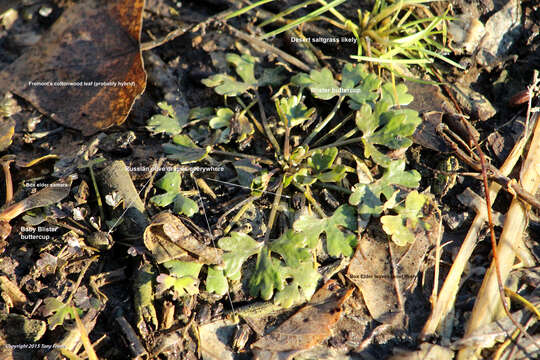Blister buttercup: not just a summer annual

Description:
All of our major local floras* currently treat Ranunculus sceleratus var. multifidus as an annual, even using that character prominently in taxonomic keys (fortunately, FNA does not). In fact, while it often does seem to behave like an annual, its lifespan is most certainly potentially longer than that (and there are a few references for this taxon from outside Utah that refer to it as an annual or short-lived perennial).This is a plant growing in mid-January after having survived some freezing temperatures (a smaller/newer plant can be seen at left with a Russian Olive drupe that has fallen right on top of it ). It is true that we have had a relative mild winter overall and the life cycle of this buttercup could well be influenced by climatic factors. The center plant pictured however likely germinated and started to grow at least by last fall. It will probably start to bloom in May or June (I have seen plants of this species blooming well into November), and so it can be either a winter annual or biennial and possibly a short-lived perennial depending on conditions.This is a fascinating taxon that is semi-aquatic (although grouped sometimes with terrestrial buttercups which can also lead to confusion in identification) and can grow in shallow pools or on the edges of ponds completely submerged with its leaves floating on the water in its initial aquatic phase. It can however also start growing on moist soil that essentially never dries out. Then when the water level declines but the soil remaining moist, it ultimately produces abundant branching flowering stalks (and as with many other particularly aquatic buttercups, it has strongly dimorphic leaves) and often flowers over a long period of time, dependent no doubt on available moisture. This species is no doubt an important evolutionary link between completely aquatic versus truly terrestrial buttercups.Jan. 17, 2015, Salt Lake County open space, approx. 4,335 ft. elev.*An exception to a local fora that instead treats this differently is Stephen Clark's field guide for the Flora of the Central Wasatch (and adjacent valleys) dated January 2012. In his key, he includes it in a section of perennials (with no reference to it being an annual). This really though isn't exactly right either and could also lead to misidentifications.
Included On The Following Pages:
- Life (creatures)
- Cellular (cellular organisms)
- Eukaryota (eukaryotes)
- Archaeplastida (plants)
- Chloroplastida (green plants)
- Streptophyta
- Embryophytes
- Tracheophyta (ferns)
- Spermatophytes (seed plants)
- Angiosperms (Dicotyledons)
- Eudicots
- Ranunculales (Red Columbine)
- Ranunculaceae (buttercup family)
- Ranunculus (Buttercup)
- Ranunculus sceleratus (cursed buttercup)
- Ranunculus sceleratus multifidus (cursed buttercup)
This image is not featured in any collections.
Source Information
- license
- cc-by-nc-sa
- copyright
- Tony Frates
- photographer
- Tony Frates
- original
- original media file
- visit source
- partner site
- Flickr Group
- ID


